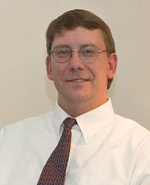Currents: campus-wide commitment
Campus-wide Commitment to Enrollment Yields Biggest Class in Colby-Sawyer's History
 “Another one just sent a deposit – that puts us close to capacity,” Vice President of Enrollment Management Greg Matthews enthuses on a mid-July afternoon.
“Another one just sent a deposit – that puts us close to capacity,” Vice President of Enrollment Management Greg Matthews enthuses on a mid-July afternoon.
He's referring to the capacity of the campus – Colby-Sawyer College is set to welcome its largest class ever when the 380 members of the Class of 2011 move into their residence hall rooms on Sept. 7. This record-breaking enrollment follows a year of refocused attention on individual applicants, intensified communications from the very first point of contact, and a strengthening of the personal touches that make the college stand out.
This effort was expended not only by the Admissions and Financial Aid Offices, but every part of Colby-Sawyer.
Interim Vice President of Enrollment Management Judy Muyskens devoted herself to increasing enrollment before departing for new adventures with the Appalachian College Association. When Colby-Sawyer welcomed Matthews in April, he immediately noted that the campus community was working together to create a deeply personal approach to admissions. “The success of this year's admissions process,” he says, “is a result of the entire institution working together. And it's been well-managed so we know there will be enough resources – classrooms, dorm rooms, et cetera – to accommodate them.”
The atmosphere in the arena of enrollment is one of great excitement, and it's been building all year long.
“By the end of March, we were sure things were going well. By mid-April we knew for sure, and by May 1 we realized that the class numbers were even greater than the 330 we had hoped for,” says Matthews.
The increased enrollment makes up, in only one year, a shortfall seen in the class of 2010 when just 239 students arrived on campus.
A Communications Campaign
 “I think last year's admissions challenges were part of a global population shift. The dip in enrollment was unexpected, definitely,” says Tracey Perkins, senior associate director of Admissions. “New Hampshire students are consistently the largest population in our student body, and fewer of them are going to college, so we were a victim of that. But we also moved away from some of the personal touches like hand-written notes and regular phone calls that have traditionally been a part of our admissions process."
“I think last year's admissions challenges were part of a global population shift. The dip in enrollment was unexpected, definitely,” says Tracey Perkins, senior associate director of Admissions. “New Hampshire students are consistently the largest population in our student body, and fewer of them are going to college, so we were a victim of that. But we also moved away from some of the personal touches like hand-written notes and regular phone calls that have traditionally been a part of our admissions process."
To correct that courtship course, and provide continuity during a time of transition in admissions and financial aid leadership, Colby-Sawyer collaborated with education consulting firm Noel–Levitz to evaluate and strengthen the college's enrollment process. Matthews says Colby-Sawyer made the right choice to seek assistance, and that Noel-Levitz did a good job of focusing the Admissions Office.
Already devoted to providing each student and family with the best overall experience possible, Colby-Sawyer intensified its message emphasizing the college's People, Place and Programs. The goal of this communications campaign was to reach out to prospective students and their families at all the vital points in the application process, and to really get to know the incoming students. As a result, not only does Colby-Sawyer know the Class of 2011 before they even arrive on campus better than any group before them, the incoming students really understand the college and will arrive in the fall with an unprecedented sense of community.
“Because we've worked with them so closely, this class is truly going to come in with a sense of who they are at Colby-Sawyer. They have this even before they get here,” says Perkins. “As a result of reaching out even more than in previous years by calling to say thank you for applying, congratulating them on their acceptance, discussing financial aid and making sure they came to visit campus, we're hoping that another benefit will be an extremely high retention rate of this class.”
Financial Aid 101 For All
A significant factor in the early solidification of the class was increased counsel regarding financial aid. After meeting with the Financial Services and Financial Aid Offices to learn about those areas and billing processes, admissions counselors were equipped to talk with families more in-depth about their financial aid awards and confirm that parents understood the offers. This new level of communication highlighted the gap between what admissions counselors thought families knew, and what they actually knew.
“We gave our families a lot more education about the whole process and did depth sounding, which was a line-by-line explanation of the aid package. It was very comforting for parents – and for us – to have those conversations because they helped families decide whether Colby-Sawyer was financially feasible very early on,” Perkins explains.
 Director of Financial Aid Ted Craigie says that typically he would have processed 850-1,000 financial aid applications from interested students, while this year the number reached nearly 1,300.
Director of Financial Aid Ted Craigie says that typically he would have processed 850-1,000 financial aid applications from interested students, while this year the number reached nearly 1,300.
“That is a significant increase for an institution our size, and points to the admissions staff generating more applications. I'm convinced that the year before, with its small class, was just a blip on the radar, just one of those years that did not work out,” says Craigie, who returned to the Financial Aid Office in October after a year working in Information Resources.
Between 80 and 85 percent of the incoming class will receive grants from Colby-Sawyer, with packages ranging from $1,000 to more than $20,000. In what Matthews calls a “back to basics, upfront approach,” financial aid awards were presented as a “first best offer” and went out the first week of March, among the earliest of any school. Families were then able to make their decisions and move through the process so that at this point in the summer, according to Craigie, while the number of questions he's hearing about paying for a Colby-Sawyer education may not have decreased, the tone has changed.
“They're more dotting their I's and crossing their T's than expressing total confusion,” he says. “I feel like families are more knowledgeable now about the process because Colby-Sawyer keeps improving its communications.”
The Caring, Active Class of 2011
So who are these newest members of the Colby-Sawyer community? Following a national trend, the Class of 2011 is predominantly female, with 70 percent women. They come from 18 states and five other countries, but staying true to its identity as a strong regional college, Colby-Sawyer will welcome students from New Hampshire first and foremost (127).
The New Hampshire students are followed closely by students from Massachusetts (120), and others from Vermont (49), Maine (27) and Connecticut (21). New York, Maryland, Rhode Island, Pennsylvania and Colorado residents will also move onto the hill, as will students from China, Nepal and Japan, and students with Spanish and Canadian backgrounds.
Almost every member of the class has visited campus, and academically they are in line with past years: more than 20 percent have high school GPAs higher than a 3.5. They are an active group, arriving on campus with athletic and community service involvement, stamps in their passports, work experience and more. Among them are artists, hunters, political activists, business owners, mountaineers, at least one trapeze artist and a member of the Junior National Fencing Team.
“They are strong in a lot of areas,” Perkins says with pride. “And as admissions counselors, in addition to talking about the experience that one can have at Colby-Sawyer – the small classes, the hands-on professors, the engaged community where you can get involved with new things – we talk a lot about the college's ability to prepare students for professional experience through internships and the jobs that graduates are getting.”
This message hit home, as illustrated by the number of first-year students interested in pursuing one specific area of study – nursing. At present, 90 first-year students have expressed a desire to study nursing, twice the number in the typical class.
Hints of the intense interest came as early as last summer, and Perkins attributes it both to increased discussion of internships and the Nursing Department's close affiliations with the world-class Dartmouth-Hitchcock Medical Center. Other top choices for incoming students are exercise and sports sciences, business administration, and early childhood education.
An Engaged Community
Adapting to the changes required by the unexpectedly small Class of 2010, the admissions staff enjoyed across-the-board support from every sector of the Colby-Sawyer community, and appreciates the campus-wide effort.
“We definitely did not admit this class alone this year,” Perkins emphasizes. “The entire campus was behind us and our goal of increased enrollment, so everyone jumped on board to help. We had faculty calling prospective students, which was a huge part in helping us build relationships, and we had support from staff in residential life, student development, the maintenance staff, everyone.
“Ultimately, that was the biggest lesson for us, that we need to engage our whole community in the enrollment process,” she adds, “because students aren't choosing this college based on meeting their admissions counselor. They're choosing it when the dining hall staff smiles at them or the faculty welcomes them to sit in on classes, and when they see how beautiful the campus is when they visit. All of that plays a part, and presents the big picture of what Colby-Sawyer is to its community.”
Moving forward, Vice President Matthews plans to keep and strengthen the campus-wide involvement regarding enrollment, noting that a college must always check itself to make sure it's serving the college and prospective students well. The goal is not increasingly large classes but finding the right number of students who are the best fit for Colby-Sawyer - students who really want to be at the college as a result of a relationship nurtured through upfront and frequent communications.
As an early sign that Colby-Sawyer has found sustainable admissions success, the four Harbor Day information sessions scheduled for August are full, with waiting lists for each event.
“We'll keep trying to meet every family's needs through more systematic and personal outreach,” says Matthews. “Our goal for the class of 2012 is 355 students, and because there is rolling admissions, Colby-Sawyer will become more selective through the volume of applications. I would advise students to apply as soon as possible. We have a strong regional presence and the interest we saw this past year is going to continue. There are many good schools, but I truly believe Colby-Sawyer is a great school.”


